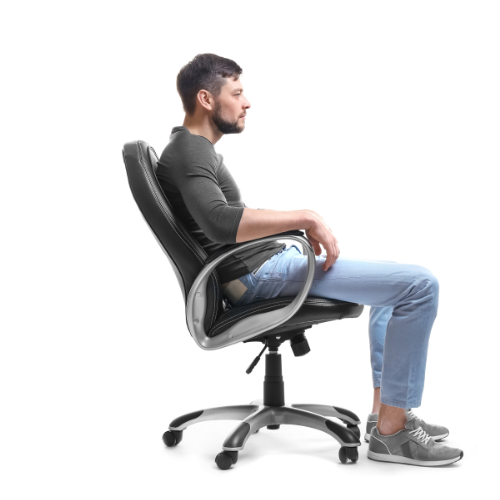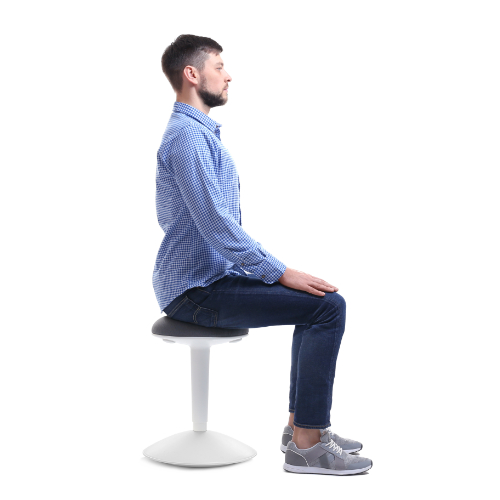Q: What can fix posture quickly?
A: There are no quick-fixes for poor posture.
Poor posture is not formed overnight. It the accumulation of years of repeated tendencies and habit. This includes hunching, slouching, leaning, and twisting for prolonged periods at a desk or repeated carrying and hauling of heavy loads using a preferred side of the body. Lack of overall physical activity can exacerbate poor posture by causing weaknesses that create slouching and hunching.
Correcting poor posture requires a reciprocal amount of time and effort to address the years that created poor posture.
Q: How can someone permanently fix their posture?
A: Good posture for a lifetime requires lifelong maintenance.
Correcting posture requires corrective habits and exercise to overcome years of atrophy, strains, and muscular asymmetries. Maintaining these corrections requires a continuation of activity and habits to maintain strength and flexibility.
Q: Can you fix posture at 40?
A: Yes, absolutely.
Barring an acute injury or structural condition, posture can be improved at any age. Proper strength and flexibility training can be designed for any age or level of athleticism to build good posture through calisthenics, isometric exercises and resistance training.
Q: Can you fix posture while sitting?
A: No, but improvements can be made.
Prolonged sitting fundamentally weakens muscles in the buttocks, abdomen, and posterior chain: Muscles normally used to stand and walk.
Chairs that recline or provide artificial lumbar support (even “ergonomic” models) pull the hips and core away from the desk. This inherently creates persistent hunching of the shoulders and craning of the neck.
Address these stressed positions with proper placement of the keyboard, mouse, and monitors. Monitors risers help keep the head upright by raising monitors to eye-level. Wrist pads reduce slouching by engaging the arms, preventing them from sagging the shoulders.
A barstool that allows the knees to rest below the hips, a person can engage their buttocks, trunk, shoulders, and posterior chain while sitting far more effectively than high-backed office chair.
Q: Can you fix posture while sleeping?
A: No, the body will assume its neutral body posture while asleep.
One’s neutral body posture is established by years of postural habits and tendencies as well as one’s athletic bearing established by one’s level of exercise and activity. This holds true even in microgravity.

The optimal sleeping position is flat on one’s back, arms to the side, legs straight with a support pillow under the knees, and using a small pillow to maintain a neutral-head position. Too many pillows, soft mattresses, and excessively heavy comforters can exacerbate poor posture while sleeping. Positions that hold the head and neck to any one side or forward can create strains in the neck.
Q: Can walking fix posture?
A: Yes, regular walking can improve posture.
Walking is an activity that can be performed to strengthen numerous muscles that create good posture. Walking also allows a person to actively recruit stabilization muscles to keep the hips, shoulders, and head aligned while in motion.
It is important to maintain an upright neck, forward gazed, tucked chin, engaged abdominal muscles, and while engaging the hip muscles to walk with a symmetrical gait. Frequency should be 4-7 days per week for 40-60 minute sessions.
Walking shoes should be flat-soled: No heels or lifts. Heels will only encourage unnatural compensation to maintain balance and are very likely to encourage poor posture.
Q: Can lifting weights fix posture?
A: Yes, strength training focused on using strict form, control, and symmetry can correct posture.
Resistance training using correct form, full-range-of-motion, and symmetry of motion can drastically improve posture.
By rebuilding muscles that have atrophied through a sedentary lifestyle while extending and stretching muscles that have become strained through prolonged hunching and slouching. By activating stabilizers to maintain alignment of the ankles, hips, knees, and shoulders, many lifts can improve posture and restore symmetry.
Q: Can deadlifts fix posture?
A: No, deadlifts are not ideal for posture correction.
While traditional deadlifts can strengthen numerous muscles in the legs, hips, shoulders, and back, compound movements such as deadlifts often challenge balance and control across multiple planes of motion while allowing for a wide range of compensation when good form is absent.
Since symmetry of the hips, shoulders, trunk, and legs are often compromised by poor posture, it could be difficult to maintain proper alignment of the body during heavy compounds lifts such as deadlifts.
A combination of front-squats, hip-bridges, and single-leg deadlifts would be more productive in building symmetry and balance to correct posture.
Q: Can running fix posture?
A: No, running is not ideal for correcting posture.
With walking, it is possible to recruit stabilizers to actively maintain proper hip, shoulder, and head alignment while in motion.
Since running requires alternating states of stability and instability to achieve a fluid stride, it would be difficult to actively recruit stabilizers engaged in maintaining balance and form during a run.
With high-repetition high-impact exercises, asymmetric points of contact will force the body to assume asymmetric movements to counterbalance itself while running.
Q: How can you fix posture in 4 moves?
A: See below!
The “4 Moves” that will correct poor posture are:
- Awareness and knowledge to identify signs of poor posture and the activities and habits that formed them.
- Optimize daily habits and surroundings to reduce repetitive hunching, leaning, and twisting of the body throughout one’s day.
- Engage in long-term strength and flexibility training to correct and improve postural imbalances and asymmetries.
- Maintaining one’s good posture through continued awareness and engaging in an active life.
There are no easy fixes for poor posture, but it is easy to incorporate new habits and activity that will help improve and maintain good posture over time.


